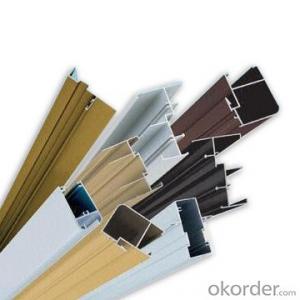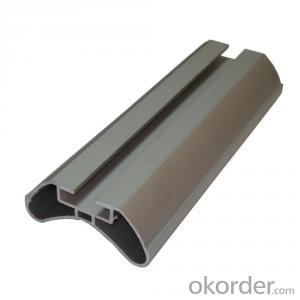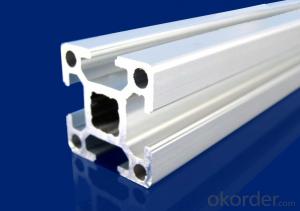Customized 6063 t5 aluminum profile
- Loading Port:
- China Main Port
- Payment Terms:
- TT OR LC
- Min Order Qty:
- -
- Supply Capability:
- -
OKorder Service Pledge
OKorder Financial Service
You Might Also Like
Aluminium is a relatively soft, durable, lightweight, ductileand malleablemetalwith appearance ranging from silvery to dull gray, depending on the surfaceroughness. It is nonmagnetic and does not easily ignite. A fresh film ofaluminium serves as a good reflector (approximately 92%) of visible lightand an excellent reflector (as much as 98%) of medium and far infraredradiation. The yield strength of pure aluminium is 7–11 MPa,while aluminium alloys have yield strengths ranging from200 MPa to 600 MPa. Aluminium has about one-third the densityand stiffness of steel. It is easily machined,cast, drawn and extruded.
Aluminium alloys (or aluminum alloys; see spellingdifferences) are alloysin which aluminium(Al) is the predominant metal. The typical alloying elements are copper, magnesium,manganese,silicon,tin and zinc. There are twoprincipal classifications, namely casting alloys and wrought alloys, both of which are furthersubdivided into the categories heat-treatableand non-heat-treatable. About 85% of aluminium is used for wrought products,for example rolled plate, foils and extrusions.Cast aluminium alloys yield cost-effective products due to the low meltingpoint, although they generally have lower tensile strengthsthan wrought alloys. The most important cast aluminium alloy system is Al–Si,where the high levels of silicon (4.0–13%) contribute to give good castingcharacteristics. Aluminium alloys are widely used in engineering structures andcomponents where light weight or corrosion resistance is required
Features:
Material | Alloy 6063,6061,6005or according to customer’s choice |
Temper | T3, T4, T5, T6 |
Surface | Anodize, electrophoresis, powder coating, PVDF coating, wood grain painting, matted, etc. |
Length | Coating 6.5 meters, Anodizing 6.5 meters, Mill finish 5 meters |
Application | Industrial, electrical equipment(TV set, air conditioner, refrigerator, computer), decoration,construction, transportation |
Custom Made | We can package following with customer's request. |
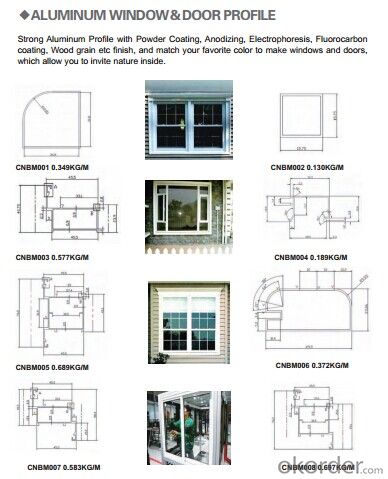


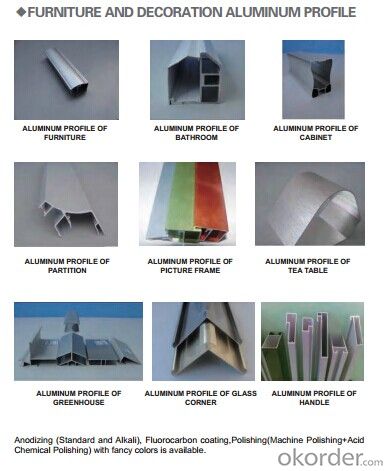
FAQ:
1. What is the form of payment?
Normally 30% TT, L/C at sight
2. Type of quotation?
FOB, CFR, CIF
3. Port of loading?
Shenzhen/Guangzhou port
4. Delivery time?
15-20 days after client’s deposit
- Q:Can aluminum profiles be used in elevator or escalator systems?
- Indeed, elevator or escalator systems can incorporate aluminum profiles. These profiles possess qualities such as being lightweight, durable, and resistant to corrosion, rendering them appropriate for a range of uses, including the construction of elevator and escalator elements. Aluminum profiles can serve as the structural framework, handrails, cladding, and other components within an elevator or escalator system. Furthermore, these profiles can be effortlessly tailored and manufactured to fulfill the exact specifications of each project. The adaptability, ratio of strength to weight, and visual attractiveness of aluminum profiles establish them as a superb option for elevator and escalator systems.
- Q:Can aluminum profiles be used in cleanroom environments?
- Cleanroom environments can indeed utilize aluminum profiles. With its lightweight and adaptable nature, aluminum possesses a multitude of desirable qualities that make it well-suited for cleanroom applications. Being non-corrosive, non-magnetic, and boasting a high strength-to-weight ratio, aluminum is an ideal material for constructing cleanroom structures like walls, partitions, and equipment racks. Moreover, the assembly and disassembly of aluminum profiles are effortlessly accomplished, allowing for flexible cleanroom configurations and future modifications. These profiles can also be seamlessly integrated with other materials such as glass, acrylic, or stainless steel, in order to meet specific cleanroom requirements. Furthermore, aluminum profiles can be enhanced by anodization or coatings to fortify their cleanliness and resistance to contamination. Anodization furnishes a protective layer on the aluminum surface, rendering it more resistant to scratches and wear. Coatings like epoxy or powder coatings can further enhance the profiles' durability and cleanliness. In summary, aluminum profiles offer a multitude of advantages for cleanroom applications, including their lightweight nature, strength, corrosion resistance, and design flexibility.
- Q:What are the different surface protection methods for aluminum profiles?
- Aluminum profiles have various options for surface protection, each providing unique benefits and safeguarding against different environmental factors. Anodizing, powder coating, and liquid coating are among the most commonly used methods. Anodizing is favored for aluminum profiles due to its ability to offer exceptional corrosion resistance and improve the metal's appearance. This technique involves immersing the aluminum profile in an electrolyte solution and applying an electric current to generate an oxide layer on the surface. Anodizing can be done in different colors, allowing for personalization and visual appeal. Powder coating is another extensively employed approach for safeguarding aluminum profiles. During this process, a dry powder is electrostatically applied to the metal's surface and then cured in an oven. The powder melts and forms a durable protective layer, providing resistance against scratches, UV rays, and chemicals. Powder coating is available in a wide array of colors and finishes, offering both protection and aesthetic choices. Liquid coating, such as liquid paint or lacquer, can also be utilized to shield aluminum profiles from corrosion and other environmental elements. Liquid coatings offer versatility in terms of color and finishes, enabling customization and meeting specific design requirements. However, compared to anodizing or powder coating, liquid coatings may be less long-lasting and require more maintenance over time. Furthermore, mechanical finishing techniques like brushing or polishing can be employed to protect aluminum profiles. These methods assist in eliminating imperfections and creating a smooth and visually appealing surface. To summarize, the range of surface protection methods for aluminum profiles includes anodizing, powder coating, liquid coating, and mechanical finishing techniques. Each method presents distinct advantages in terms of corrosion resistance, durability, aesthetics, and customization options. The choice of surface protection method ultimately depends on the specific requirements, budget, and desired appearance of the aluminum profiles.
- Q:Can aluminum profiles be used in solar reflector systems?
- Yes, aluminum profiles can be used in solar reflector systems. Aluminum is a commonly used material in solar reflector systems due to its high reflectivity, durability, and lightweight properties. It can effectively reflect sunlight onto solar panels or other target areas, making it suitable for solar energy applications.
- Q:What are the vibration damping properties of aluminum profiles?
- Aluminum profiles have excellent vibration damping properties. Due to their high stiffness-to-mass ratio, aluminum profiles effectively absorb and dissipate vibrations, reducing their magnitude and preventing their transmission to surrounding structures. This property makes aluminum profiles ideal for applications where vibration control is critical, such as in the aerospace, automotive, and construction industries. The inherent damping characteristics of aluminum profiles help in minimizing noise, minimizing wear and tear, and ensuring structural integrity. Additionally, aluminum's ability to dampen vibrations also enhances the overall comfort and safety of various products and structures.
- Q:What are the standard dimensions of aluminum profiles?
- The standard dimensions of aluminum profiles can vary depending on the specific application and industry. However, some common standard dimensions include widths ranging from 10mm to 200mm and heights ranging from 10mm to 100mm. The length of aluminum profiles can also vary, with standard lengths typically ranging from 2 meters to 6 meters. It is important to note that these dimensions can be customized to meet specific project requirements.
- Q:What are the different types of fasteners used for aluminum profiles?
- For aluminum profiles, there exists a range of fasteners that are commonly employed. These include: 1. T-slot nuts: These nuts are specifically designed to fit seamlessly into the T-slot grooves found on aluminum profiles. Equipped with a threaded hole, they enable the attachment of bolts, screws, and other fasteners. 2. Bolts and screws: These fasteners serve the purpose of securing aluminum profiles either to each other or to other components. They are available in various lengths and sizes, catering to different applications. 3. Corner brackets: Corner brackets are implemented to establish robust joints between aluminum profiles at right angles. Typically, they are equipped with holes for the easy attachment of screws or bolts. 4. T-bolts: T-bolts resemble regular bolts, with the exception of a T-shaped head that fits snugly into the T-slot grooves of aluminum profiles. This design enables rapid and secure attachment without the need for nuts or additional hardware. 5. Angle brackets: Angle brackets are utilized to establish joints between aluminum profiles at varying angles. Usually featuring holes for screws or bolts, they facilitate the secure connection of profiles. 6. Clamps: Clamps are employed to hold aluminum profiles in place or to affix them to other components. They are available in diverse designs, such as lever clamps or eccentric clamps, and can be effortlessly adjusted and tightened for a secure fit. 7. End caps: These caps are specifically designed to cover the ends of aluminum profiles, offering a polished appearance while safeguarding the profile from debris or potential damage. These examples represent merely a selection of the diverse fasteners employed for aluminum profiles. The choice of fastener ultimately depends on the specific application and the desired level of strength and versatility.
- Q:How is the aluminum alloy profile series divided?
- According to alloy composition.1 pure aluminum, such as 1100,2 series aluminum alloy3 Series al Mn alloys, such as 3003, 3A214 series Al Si alloy5 Series Al Mg alloy6 series Al Mg Si alloy, such as 606360617 Series Al Zn Alloy8 lines, others9 line standby
- Q:Can aluminum profiles be custom-designed or customized?
- Yes, aluminum profiles can be custom-designed or customized according to specific requirements. Aluminum is a highly versatile material that can be easily shaped and manipulated into different forms. Customizing aluminum profiles allows for the creation of unique shapes, sizes, and finishes to meet the specific needs of various applications. Custom design and customization of aluminum profiles can involve altering dimensions, creating intricate shapes, adding slots or holes for assembly, incorporating specific features or accessories, and even applying various surface treatments or coatings. This flexibility in design and customization enables aluminum profiles to be used in a wide range of industries and applications, such as construction, automotive, aerospace, electronics, and more. The process of customizing aluminum profiles typically involves collaboration between the manufacturer and the customer. The manufacturer will work closely with the customer to understand their requirements, provide technical support, and offer design solutions that meet their specific needs. This may include creating prototypes, conducting tests, and making adjustments until the desired custom design is achieved. Overall, aluminum profiles can indeed be custom-designed or customized to suit specific requirements, making them a preferred choice for many industries seeking unique and tailored solutions.
- Q:Can aluminum profiles be used for agricultural or farming applications?
- Yes, aluminum profiles can indeed be used for agricultural or farming applications. Aluminum profiles offer several advantages that make them suitable for these applications. Firstly, aluminum is lightweight, which makes it easy to transport and install. This is particularly beneficial in agricultural settings where mobility and flexibility are essential. Additionally, aluminum is highly resistant to corrosion, making it ideal for use in harsh environments such as farms where exposure to moisture, chemicals, and fertilizers is common. Its resistance to rust ensures durability and longevity, reducing the need for frequent replacements. Furthermore, aluminum profiles can be easily customized and fabricated to meet specific requirements. This flexibility allows for the creation of structures like greenhouse frames, support beams, shelving systems, and other components needed in agricultural operations. Moreover, aluminum profiles are non-toxic and do not release any harmful substances into the surrounding environment. This makes them safe for use in farming applications, where the health and well-being of animals and crops are of utmost importance. Lastly, aluminum is a sustainable material that can be recycled indefinitely, reducing its environmental impact. This aligns with the growing focus on sustainability in agriculture. In conclusion, due to their lightweight nature, corrosion resistance, adaptability, safety, and sustainability, aluminum profiles are indeed suitable for various agricultural and farming applications.
1. Manufacturer Overview |
|
|---|---|
| Location | |
| Year Established | |
| Annual Output Value | |
| Main Markets | |
| Company Certifications | |
2. Manufacturer Certificates |
|
|---|---|
| a) Certification Name | |
| Range | |
| Reference | |
| Validity Period | |
3. Manufacturer Capability |
|
|---|---|
| a)Trade Capacity | |
| Nearest Port | |
| Export Percentage | |
| No.of Employees in Trade Department | |
| Language Spoken: | |
| b)Factory Information | |
| Factory Size: | |
| No. of Production Lines | |
| Contract Manufacturing | |
| Product Price Range | |
Send your message to us
Customized 6063 t5 aluminum profile
- Loading Port:
- China Main Port
- Payment Terms:
- TT OR LC
- Min Order Qty:
- -
- Supply Capability:
- -
OKorder Service Pledge
OKorder Financial Service
Similar products
New products
Hot products
Hot Searches
Related keywords
